A rural childhood in interwar Oxfordshire: An Appreciation of Mollie Harris & A Kind of Magic
by Peter Bartrip
Food waste? Never. Nose to Tail eating? Always. Foraging? Absolutely. Recycling? Definitely. This is not the check list of a twenty-first century culinary environmentalist, but the reality of living in rural poverty in England less than a century ago, as recalled by Mollie Harris in her splendid memoir of an Oxfordshire village childhood in the aftermath of the First World War.
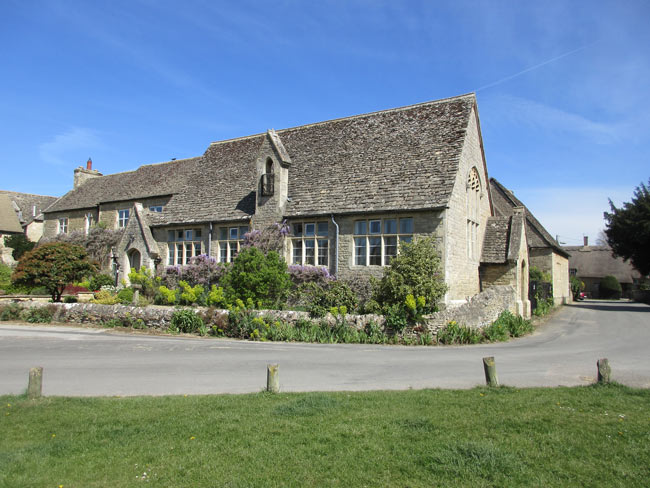
A cottage in current day Ducklington.
Frederica Mollie Victoria Harris (née Woodley) 1913-1995, universally known as Mollie, was a bona fide Oxfordshire character who lived her entire life within five miles of her birthplace. Born into humble circumstances with a father who died of peritonitis two months before her birth, she mined her lowly origins and love of the countryside to fashion parallel careers as broadcaster, author and actress. Well before the end of her life she had become a ‘national treasure,’ largely through her portrayal of Martha Woodford, a leading character in the BBC Radio 4’s long-running (70 years and counting in 2021) radio soap opera, The Archers, ‘an everyday story of country folk’ as it used to be termed, set in the fictional county of Borsetshire.
After leaving her village school at the age of fourteen, Mollie’s first job was in a Witney laundry where she pressed the gentry’s clothes and acquired a life-long loathing of ironing. Her employment came to an abrupt end when, losing patience with a rude and critical boss she walked out and found work elsewhere within the hour. During world war two she drove a three ton grocer’s lorry, delivering cheese and large sacks of sugar, salt and flour across Oxfordshire and surrounding counties. Later she worked on farms, helping with such tasks as sorting potatoes and bringing in the harvest. In the process she began to write about her experiences, the characters she met and the stories and recipes she heard. Around 1960 she submitted articles to a local newspaper which was delighted to publish them and make Mollie a regular (unpaid) contributor. When she sent some of these items to a BBC radio producer her broadcasting career began. Her relaxed demeanor and authentic Oxfordshire accent, a mellifluous burr, greatly appealed to audiences. Before long she was making regular appearances on radio and television shows that covered rural themes, including, from 1970, The Archers in which she was cast as the village shopkeeper and postmistress. The role remained hers for a quarter of a century.
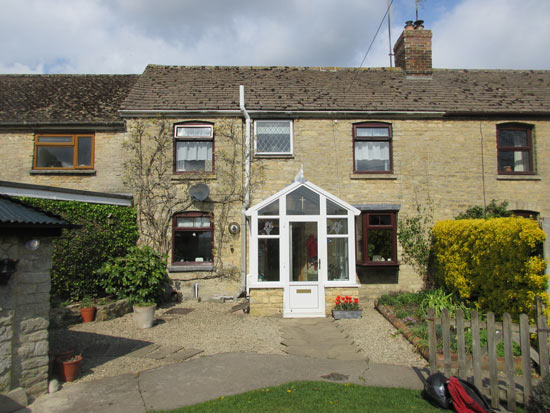
Rear garden of one of Mollie’s childhood homes, which would have been packed with vegetable growing and pig rearing.
In 1969 Harris published her first book. A Kind of Magic described her childhood within a large family of siblings and step siblings in the (then) tiny village of Ducklington in the Windrush Valley. It addressed such matters as school, local characters, games and pastimes, traditional medicines, customs, celebrations, superstitions and a great deal more. The book proved a huge success and in 1974 went into a fourth impression. Many volumes followed. These included Another Kind of Magic (1971), a further autobiographical volume, The Green Years (1976), and titles on country wine-making, cookery, walking and privies. The rest of this article will focus on A Kind of Magic because of what it tells us about the production, collection, preparation and consumption of food in an impoverished context in 1920s rural England.
A considerable portion of the book deals with how people ‘got by’ or in some cases didn’t. On Saturday nights the poor walked to the nearby town of Witney to buy leftover bones and ‘bits’ of meat from the butcher which they could use to make a meat pie or pudding. Since nobody could afford ‘boughten’ fruit and vegetables, every villager had an allotment as well as a garden on which they endeavored to grow enough produce to last the year. The fertility of plots was maintained with pig manure and the contents of household privies. During spring and summer men and women toiled on their allotments long into the evening. Children helped with weeding and picking up potatoes.
Most villagers kept a couple of pigs, one to be killed and salted at the end of summer for family consumption over the winter months, the other to be sold to ‘Piggy’ Humphries in order to pay bills, including those racked up in buying pig meal or toppings. Little pig food was purchased but mainly comprised garden and allotment waste such as weeds and rotten apples or ‘come by,’ that is, foraged vegetation. In summer children roamed the countryside filling hessian sacks with sow thistles, dandelion leaves, cow parsley and much else. In autumn vast quantities of acorns were collected with the aim of putting an extra couple of inches of fat on the pigs before they were slaughtered. Pigs also ate small boiled potatoes and the outer leaves of cabbages. They even received the water in which a family’s vegetables had been cooked. The animals were so important to villagers that Harris devotes a whole chapter to the subject of Pig Killing, of which more below.
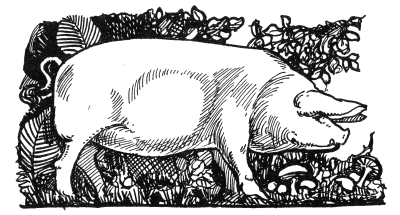
Paying ‘Piggy’ with a pig.
The unspoiled countryside provided an abundance of free food to those, often children, willing to forage for it. Mollie recalls gnawing on farmers’ turnips and swedes fresh out of the ground and searching along the banks of the River Windrush for wild duck and moorhen eggs. Although most families kept hens, any eggs found were taken home, checked for addling, and fried; nine or ten of them made ‘a nice nourishing tea.’ In season there were also mushrooms, wild strawberries, watercress and nuts to be gathered, plus crawfish from the river and the occasional poached pheasant. Mollie recalls walks between thick berried hedgerows gorging on wild berries, fruits such as crab apples and edible foliage. She and her companions ate the new leaves of the may bush, known as ‘bread and cheese,’ almost ‘as fast as they grew.’ Fifty years later she was still savoring them on country strolls. She recalls suffering severe stomach ache following her childhood foraging but somehow everyone knew which berries and other plants to avoid and she could recall no case of poisoning.
Cooking was exclusively the sphere of wives and mothers who were expected to have father’s tea ready as soon as he returned from work which, for Mollie’s stepfather was at a Witney brewery. The objective was to produce tasty, cheap and filling food that would ‘put a good lining in your insides:’
“Somehow on a great black grate our mother [Blanche] concocted wonderful meals--tasty and filling. In a great oval pot that was suspended over a good fire she cooked hunks of fat bacon along with potatoes and cabbage. The vegetables were put into string nets to keep them separate. When they were cooked she would fish them out of the steaming saucepans with the aid of a fork. Then into the same water and along with the bacon she would drop a suet pudding perhaps a roly-poly or a currant ‘spotted dick’, and sometimes just plain suet to be eaten with golden syrup on it as a special treat.”
Rabbits were trapped and eaten or sometimes sold at nine (old) pence per carcass. To cook them, the fire was ramped up and the jointed rabbits placed in the oven to the side of the fireplace along with sliced onions, halved potatoes and dripping. “And later we would all sit down and have a meal fit for a king.” Another dish comprised “three penn’orth of bones,” boiled in water with every sort of herb and vegetable available, plus suet dumplings the size of tennis balls. The process created a thick, warming stew. In later life Mollie reckoned her mother’s cooking the best she ever tasted notwithstanding “slapdash” preparation and no measuring of ingredients.
Jam making was an important part of summer and autumn. The preserve was made in huge quantities, sufficient to last a large family for a whole year, from “anything that was going” but especially blackberries and apples. Blackberries could be found in almost every hedgerow from late summer until the first frost, while nearly every garden had an apple tree and sugar cost no more than two pence a pound. During a long lean period that lasted some three years Mollie’s family “almost lived on blackberry and apple jam.” It was served in thick dollops with porridge, rosemary-flavored rice pudding, suet pudding and on toast, sometimes three times a day.
Two important events on the culinary calendar were Shrove Tuesday or Pancake Day and Christmas. Pancake Day was exciting because lemons and sugar, the standard accompaniments, were such a rare treat. The making of the Christmas pudding was a more protracted affair. Traditionally it all began on Stir-up Sunday, the first Sunday of Advent which normally fell in late November. At least it should have, but Blanche had seldom acquired all the ingredients by then. The children’s role in the process was to stone the raisins one by one and run into Witney to buy missing necessities. Eventually, all the, unmeasured, ingredients, including beer, sugar, nutmeg and a host of other spices, were thrown into a large earthenware pan and stirred. The puddings were cooked for a whole day in the old washhouse tub with a fire raging underneath and then stored for the festival. Mollie recalls them as the finest she ever tasted.
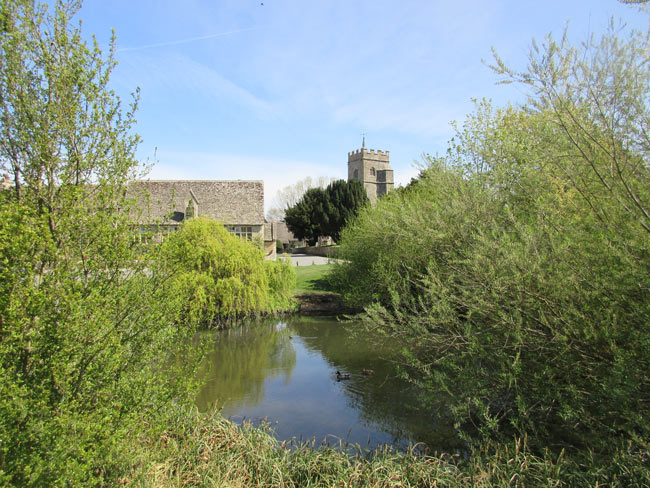
Ducklington had few shops. Mollie refers only to a confectioner and a baker, the flour for whose dough came from the village’s own, now long-since demolished, flour mill. Baker Collis’s oven served not only for bread making, it could also be rented to cook a Sunday roast. For the most part shopping meant a walk into Witney but itinerant traders or “packmen” selling such items as paraffin, household goods and sweets were regular visitors. One such was the gigantic Hog Puddin’ Walker who sold black and white puddings along with beautifully plaited chitterlings (intestines) from a wicker basket on the front of his bicycle. He covered his wares with a pristine white cloth and always had sprigs of fresh parsley dotted among the puddings.
Hog pudding brings us to the subject of pig killing. When the weather turned colder around mid-October, ‘Piggy’ Humphries was summoned to do the deed. On reflection Mollie admits that the process, in the course of which pig squeals could be heard right across the village, was gory but at the time it was so commonplace that nobody had any qualms. Mr Humphries arrived by bicycle with the tools of his trade; a pig sticker, a long sharp knife and a sharpening stone. A terrified animal was manhandled onto a bench at which point the pig sticker was plunged down its throat severing an artery. Some owners caught the blood in a basin for black pudding. The carcass was then butchered with nothing being wasted; head, trotters, chitterlings, ‘flear’ (for lard), heart, liver and kidney were all carefully preserved. Even the bladder was kept for use as a football (soccer ball). The hams, spare ribs and backbone were removed leaving two sides which once cured supplied bacon and ham for the winter.
In the absence of refrigeration fresh meat had to be eaten quickly and the “first night’s supper after a pig had been killed (liver and fat cooked in lard) was the best treat in the world.” If the weather turned warm pork consumption perforce increased rapidly:
“.… we had to gorge like mad so as not to waste a thing, and for about a week we all lived like fighting cocks, stuffing ourselves with great boiled heart and kidney puddings and wonderful faggots that our mother made from the lights, tongue and sweet herbs. She would cover each faggot with a small piece of the caul, the lacy portion of fat that protects the intestines.”
The backbone formed the basis of a ‘Boney Pie’ while the spare ribs were eaten on pig-killing Sunday, baked in the oven with large, crisp and fatty potatoes. The head and trotters were turned into brawn or collared head. They were boiled with onions, peppercorns and mace until the meat fell off the bone. It was then chopped finely and mixed with sage, pepper, nutmeg and some of the cooking liquor before being poured into greased basins. A weighted plate compressed the mixture which once cool and firm could be turned out and cut into slices. Chitterlings, once all trace of feces had been removed, a laborious and messy process in the absence of tap water, were plaited, fried and eaten cold or hot from the pan. That left just “crutlings” or shrivelled cooked fat, known as “scratchings” in other parts of the country, which were the children’s reward for helping to process the flear into lard.
The salting and pickling of the sides and hams was another job that required haste after a killing. Mollie’s stepfather rubbed salt and saltpeter into the sides. They were then placed into a tub of brine and turned regularly for several days before being covered in butter muslin and hung up to dry. Ham was sometimes treated similarly but an alternative was to rub them every day for a month with a mixture of beer, brown sugar, juniper berries and salt. They too were then dried. The bacon was eaten in great lumps, fried or boiled or as part of a “clanger,” which was a huge suet roly-poly filled with bacon and onion and boiled for hours on end.
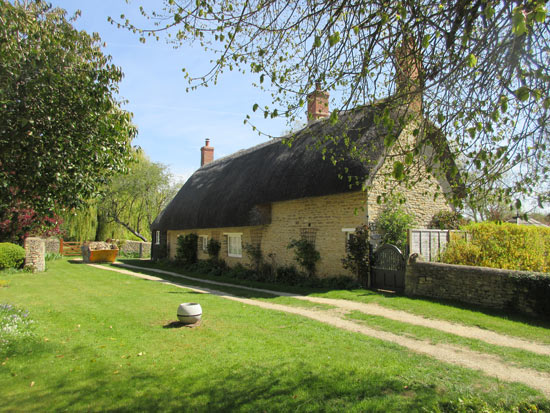
Some years ago, especially in the 1990s and early 2000s, there was a literary trend of misery memoirs, Frank McCourt’s Angela’s Ashes (1996) being a notable example. A Kind of Magic preceded this trend and decidedly was not a harbinger of it. It acknowledges that there were those who lived on the wrong side of the poverty line, some of whom suffered near starvation. These included old ladies who lived alone and sustained themselves mainly on “tea-kettle broth” that is, dry toast soaked in hot water, and pale skinny children who either died or grew up as weaklings. But Mollie’s writing fits more into the rose-tinted mould of Flora Thompson’s Lark Rise within which poverty was a reality but one that was not without compensations such as friendship and community, where basic needs were generally met and treats such as a pancake could be anticipated and enjoyed with a gusto undimmed by familiarity. Perhaps a diet heavy on bread, dripping, lard, suet pudding, fat bacon, and jam was not the healthiest, certainly in terms of modern nutritional prescription, but Mollie observes that most people seemed to thrive on it.
A discussion of Mollie Brown’s Cotswold Country Cookbook appears in the critical.
Acknowledgement and Note.
My thanks to Robin Wiltshire for permitting me to photograph his cottage where Mollie lived.
In 1983 Mollie was a guest on BBC Radio 4’s ‘Desert Island Discs.’ The recording can still be accessed on BBC Sounds via https://www.bbc.co.uk/programmes/p009mj48
